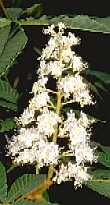View crop
View crop Data sheet EcoPortAesculus hippocastanum
 |
|
| Notes |
|---|
| DESCRIPTION: Deciduous tree reaching 15-22 m in height and 10-13 m in spread. Flowers white and showy in mid-May, quite attractive. The tree produces fruits that are made up of a spiny capsule containing one to three large seeds, known as horse chestnuts. USE: The leaves, bark and fruit have tonic, mildly astringent and anti-spasmodic properties. Some caution must be exercised in its use, as it can be poisonous. The tree is grown as an ornamental. FURTHER INF.: The tree is native of Western Asia, Greece and Albania, but it is now cultivated in many areas of Europe and North America. It is planted extensively in coastal conditions and shows no salt injury. | Sources |